If you love making fresh egg pasta at home, garganelli are a beautiful traditional shape to add to your repertoire. This handmade pasta from Emilia-Romagna is created by rolling small squares of dough around a wooden dowel on a ridged gnocchi board, which gives each piece its delicate texture.
The result is a light, hollow tube of pasta that catches sauce beautifully and feels incredibly satisfying to make.
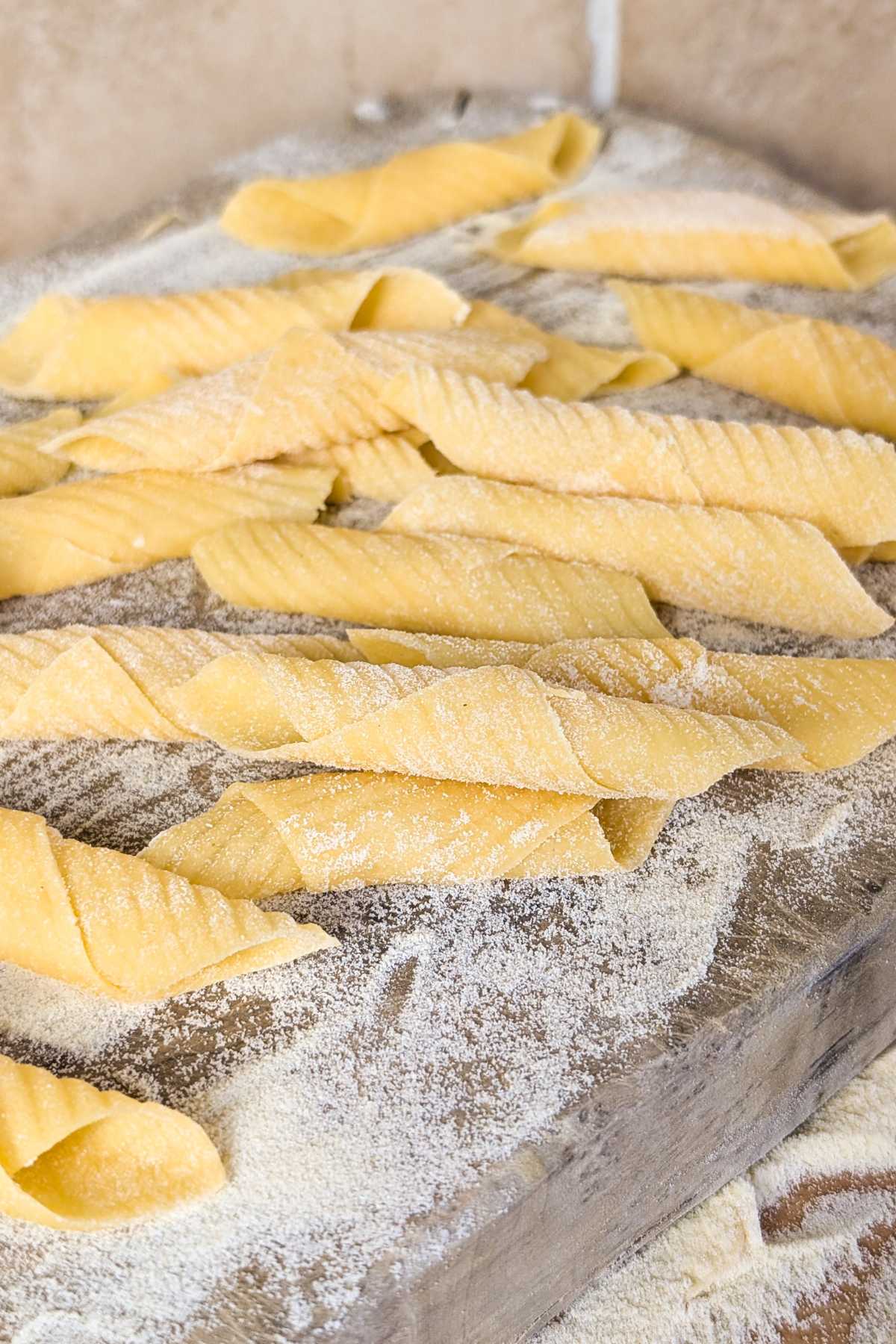
Homemade garganelli look a little like penne, but the flavor and texture are completely different. Because they’re rolled by hand, the pasta stays tender, slightly rustic and full of character.
Once you learn the technique, shaping garganelli becomes a calm, rhythmic process, perfect for anyone who enjoys traditional Italian cooking.
This pasta pairs wonderfully with almost anything: hearty meat ragù, creamy sauces or even a simple butter and sage. Thanks to the ridges and open shape, garganelli hold sauce better than many other homemade pasta cuts.
All you need to prepare them is a batch of fresh pasta sheets and a wooden gnocchi board with its small rolling dowel.
With just a few ingredients and simple tools, you can make an authentic Italian pasta shape that feels special enough for weekends but easy enough for any day of the week.
Ingredients
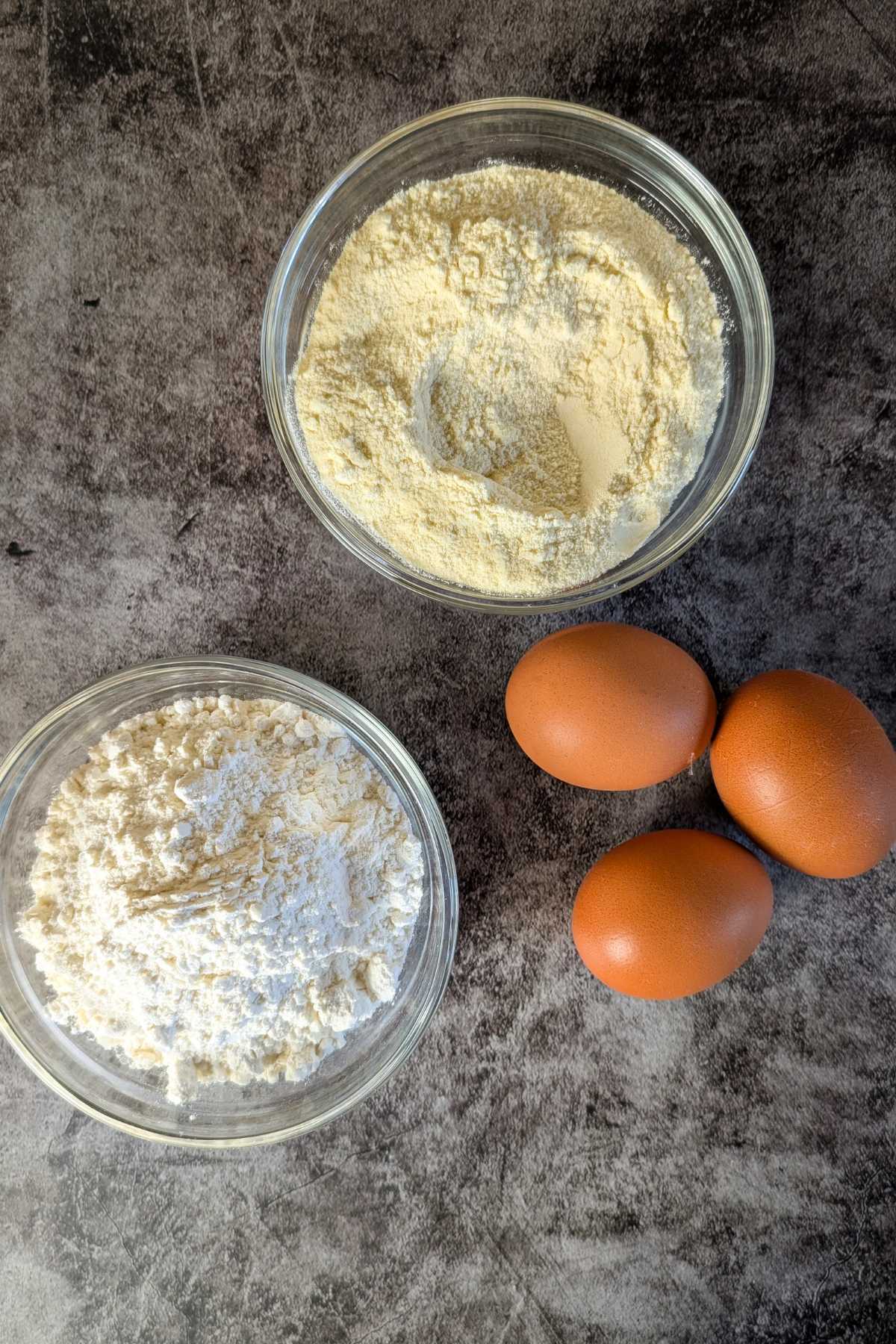
Prep Time: 30 Min | Resting Time: 30 Min | Cooking Time: 4-5 Min | Serving: 4
- 150 g (1 cup) “00” flour
- 150 g (1 cup) semolina flour
- 3 eggs (about 70 g / 2.5 oz each - 1 egg for every 100 g of flour)
Kitchen Tools and Equipment
To make homemade garganelli, you don’t need anything complicated, but having the right tools makes the process smoother and much more enjoyable.
PASTA MACHINE: The first thing is a pasta machine, whether it’s a classic hand-cranked model like Imperia or Marcato, or the pasta roller attachment for your KitchenAid mixer. Any of these will help you roll the dough into thin, even sheets without too much effort.
CUTTER: Once the pasta is rolled out, you’ll need something to cut it into small squares. A simple sharp knife works, but a pastry or pasta cutter is even better because it gives you clean, uniform edges and speeds up the work when you’re cutting many pieces in a row.
GNOCCHI BOARD: The key tool for shaping garganelli is the wooden gnocchi board with its small rolling dowel. Many boards come with the dowel included, specifically designed for this type of pasta. You place each square of dough on the ridged surface, roll it around the dowel, and the grooves transfer onto the pasta, giving garganelli their signature texture. It’s a small tool, but it makes all the difference in creating that authentic look and helping the pasta hold sauce beautifully.
Intructions
Make the Fresh Pasta Sheets
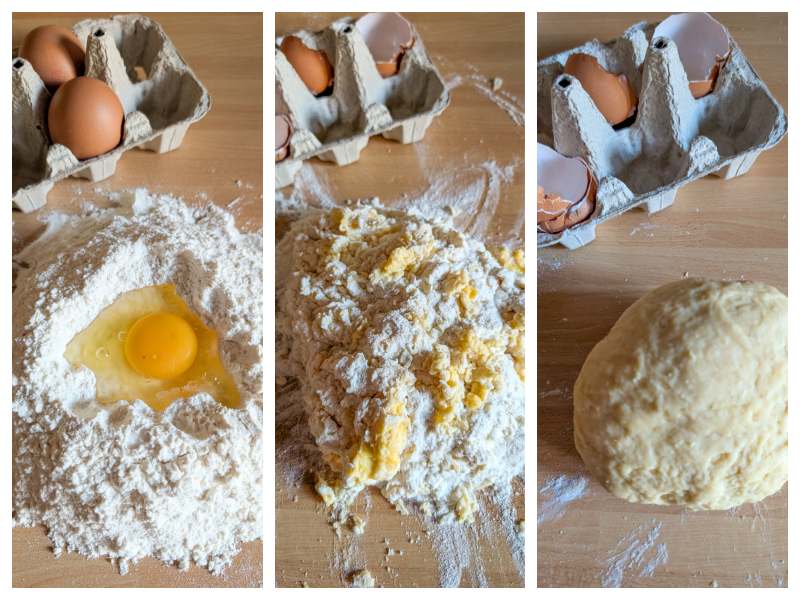
Step 1) - Start by preparing the dough. Place the flour on your work surface and shape it into a soft mound, then create a deep well in the center. Crack the eggs into the well and using a fork, begin to mix the eggs, pulling in a little flour at a time from the inner edges of the mound.
When the mixture becomes too thick to handle with the fork, switch to your hands and start kneading. Work the dough for about ten minutes, pressing and folding until it turns smooth and compact.
Shape it into a ball, wrap it well in plastic wrap so it doesn’t dry out, and let it rest for at least half an hour. This resting time allows the gluten to relax and makes rolling the dough much easier.

Step 2) - Once the dough has rested, you can start rolling it out. Cut off a portion of dough roughly the size of a tennis ball and keep the rest covered. Flatten the piece lightly with your palms, dust it with a little semolina so it doesn’t stick, and pass it through your pasta machine on the widest setting.
Fold the sheet in half or in thirds and run it through the machine again. Repeat this folding-and-rolling step a few times. This process strengthens the dough and helps you get a smooth, even surface that won’t tear while shaping the garganelli.

Step 3) - When the dough looks silky and manageable, begin thinning it. Move gradually to the narrower settings of the pasta machine, passing the sheet through each one without rushing. Stop when you reach the second-to-last setting, which gives you a thin sheet of about 1 millimeter. This thickness is ideal for forming the small squares that will become your garganelli.
For more information, tips and tricks read the full recipe for homemade pasta
Make the Garganelli Pasta

Step 4) - Lay the rolled pasta sheets on your work surface and dust them lightly with semolina so they stay dry and easy to cut.
Use a cutter or a pastry wheel to square off the edges, then slice the sheet into small even pieces, about 3 to 4 cm (1-1 ½ inch) on each side.
Place one square at a time on your wooden gnocchi board, positioning it like a diamond. Set the small wooden dowel that comes with the board across the top corner. The thickness of this dowel determines how wide the center opening of the garganelli will be once rolled.
Press the dough gently so it picks up the ridged texture of the board.
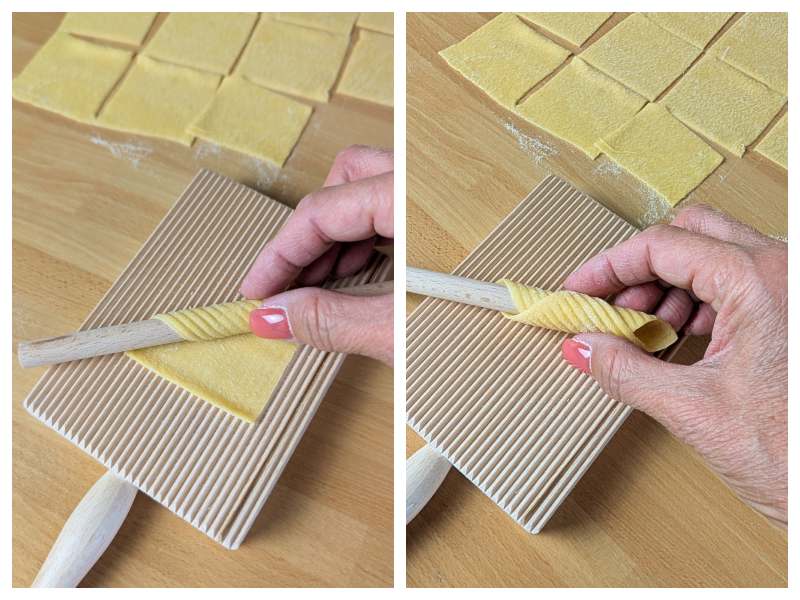
Step 5) - Roll the square around the wood stick, letting the ridges wrap all the way around. Slide the cylinder out carefully and you’ll have a neat little tube with a patterned surface that holds sauce beautifully.
Transfer each garganello to a tray sprinkled with semolina and continue until all the dough is used.
At this point, the pasta is ready to cook. Bring a large pot of salted water to a boil and cook the garganelli for just 4-5 minutes, until they turn tender but still firm. Toss them in your favorite sauce.

Storage
Once your garganelli are shaped, you can either cook them right away or store them for later. If you plan to use them the same day, simply arrange them on a tray dusted with semolina and let them air-dry for about 30 minutes. This helps them keep their shape during cooking.
For longer storage, freezing is the easiest and most reliable method. Place the freshly shaped garganelli on a tray in a single layer, making sure they don’t touch each other, and freeze until completely firm. After a couple of hours, transfer the frozen pasta into freezer bags, remove as much air as possible, and seal. They keep perfectly for up to 2 months.
When you’re ready to cook them, there’s no need to thaw. Drop the frozen garganelli straight into boiling salted water. They may need an extra minute or two compared to fresh ones, but they’ll come out just as delicious and hold their texture beautifully.

Tips
Working with fresh garganelli is simple once you get the rhythm.
- Keep your pasta sheets lightly dusted with semolina so the squares stay dry and easy to roll.
- If the dough sticks to the gnocchi board, use just a touch more flour.
- When shaping the pasta, press firmly enough to transfer the ridges but not so hard that the dough tears.
- Try to keep your squares the same size so the pasta cooks evenly, and don’t rush the rolling step: a slow, steady movement gives you a tighter, neater tube.
- Finally, remember that fresh garganelli cook very quickly, so keep an eye on the pot. They should be tender but still have a gentle bite when you drain them.
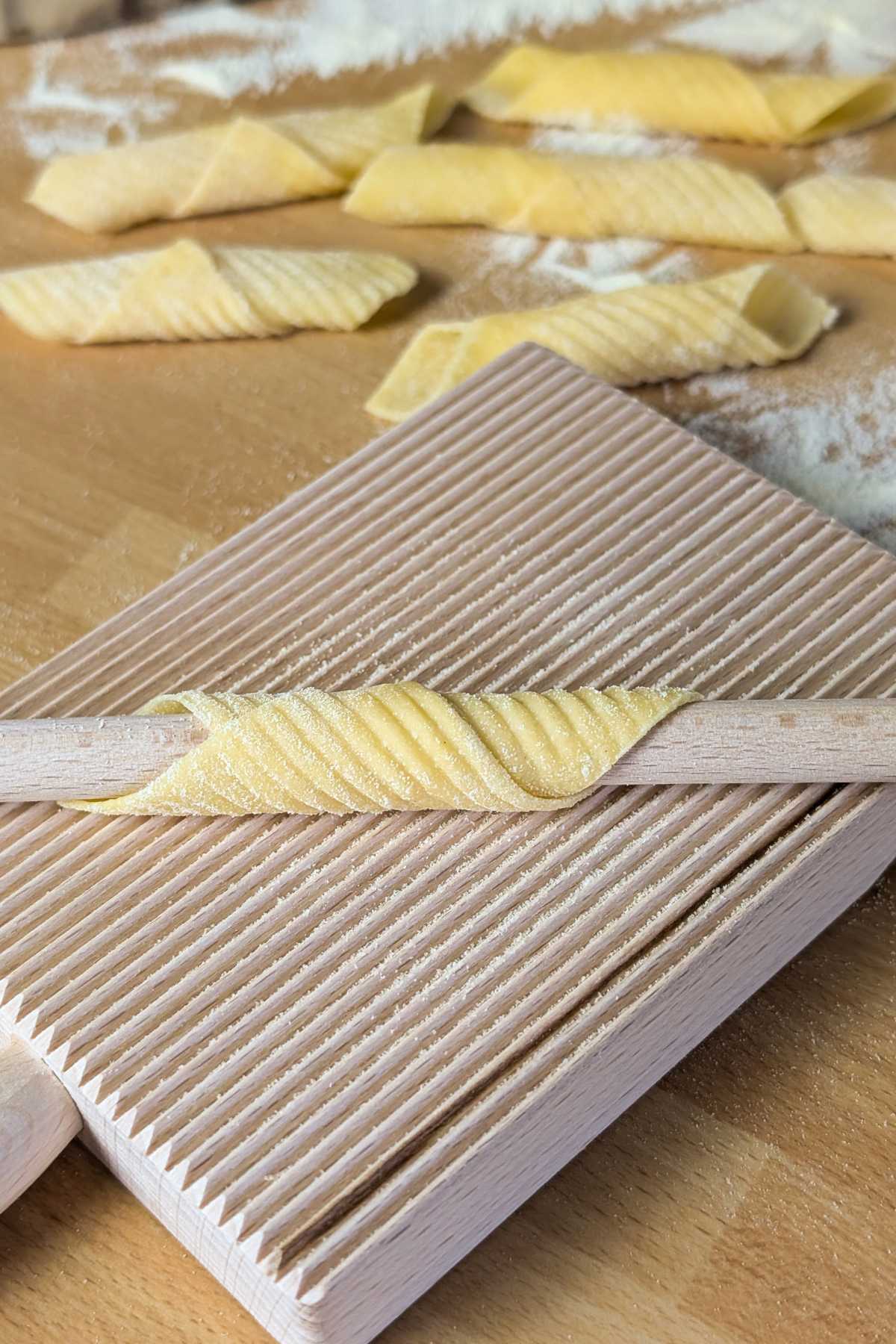
Recipe Card
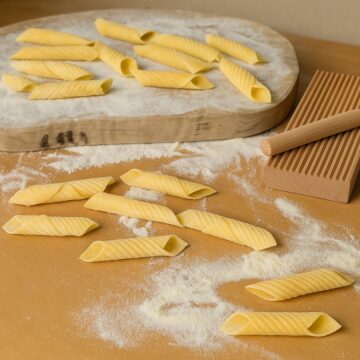
How to Make Homemade Garganelli
Ingredients
- 150 g "00" flour - 1 cup
- 150 g semolina flour - 1 cup
- 3 medium eggs - about 70 g / 2.5 oz each - 1 egg for every 100 g of flour
Instructions
Make the Fresh Pasta Sheets
- Start by preparing the dough. Place the flour on your work surface and shape it into a soft mound, then create a deep well in the center. Crack the eggs into the well and using a fork, begin to mix the eggs, pulling in a little flour at a time from the inner edges of the mound.
- When the mixture becomes too thick to handle with the fork, switch to your hands and start kneading. Work the dough for about ten minutes, pressing and folding until it turns smooth and compact.
- Shape it into a ball, wrap it well in plastic wrap so it doesn’t dry out, and let it rest for at least half an hour. This resting time allows the gluten to relax and makes rolling the dough much easier.
- Once the dough has rested, you can start rolling it out. Cut off a portion of dough roughly the size of a tennis ball and keep the rest covered. Flatten the piece lightly with your palms, dust it with a little semolina so it doesn’t stick, and pass it through your pasta machine on the widest setting.
- Fold the sheet in half or in thirds and run it through the machine again. Repeat this folding-and-rolling step a few times. This process strengthens the dough and helps you get a smooth, even surface that won’t tear while shaping the garganelli.
- When the dough looks silky and manageable, begin thinning it. Move gradually to the narrower settings of the pasta machine, passing the sheet through each one without rushing. Stop when you reach the second-to-last setting, which gives you a thin sheet of about 1 millimeter. This thickness is ideal for forming the small squares that will become your garganelli.
Make the Garganelli Pasta
- Lay the rolled pasta sheets on your work surface and dust them lightly with semolina so they stay dry and easy to cut.
- Use a cutter or a pastry wheel to square off the edges, then slice the sheet into small even pieces, about 3 to 4 cm (1-1 ½ inch) on each side.
- Place one square at a time on your wooden gnocchi board, positioning it like a diamond. Set the small wooden dowel that comes with the board across the top corner. The thickness of this dowel determines how wide the center opening of the garganelli will be once rolled.
- Press the dough gently so it picks up the ridged texture of the board.
- Roll the square around the wood stick, letting the ridges wrap all the way around. Slide the cylinder out carefully and you’ll have a neat little tube with a patterned surface that holds sauce beautifully.
- Transfer each garganello to a tray sprinkled with semolina and continue until all the dough is used.
- At this point, the pasta is ready to cook. Bring a large pot of salted water to a boil and cook the garganelli for just 4-5 minutes, until they turn tender but still firm. Toss them in your favorite sauce.


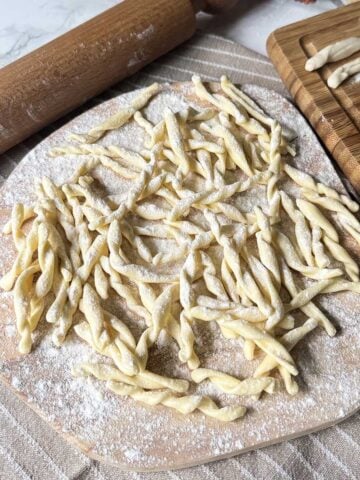


Leave a Reply